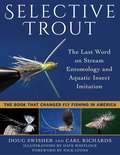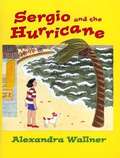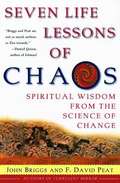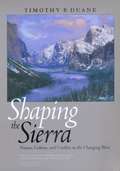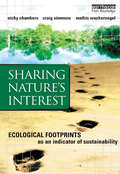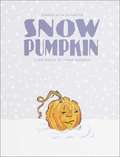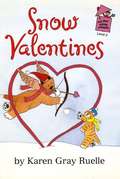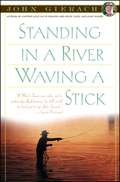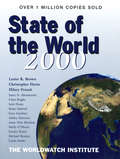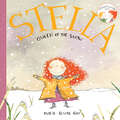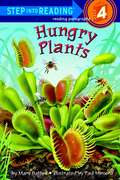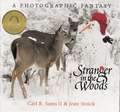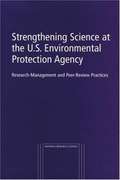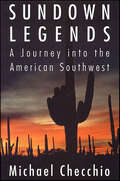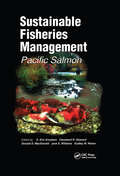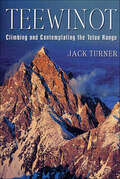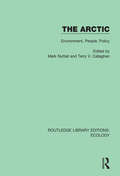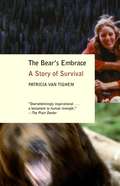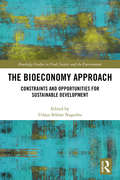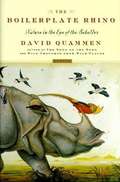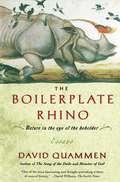- Table View
- List View
Selective Trout: The Last Word on Stream Entomology and Aquatic Insect Imitation (Lyons Press Ser.)
by Nick Lyons Carl Richards Dave Whitlock Doug SwisherWhen it was originally published in 1971, Selective Trout was universally acclaimed as the most revolutionary approach to aquatic insect imitation in the twentieth century. Using common sense, science, and imagination, authors Doug Swisher and Carl Richards developed a wide array of new patterns that were in sharp contrast to those offerings used by American fly fishermen up to that time. Their radical no-hackle dry fly, in particular, proved to be a more convincing, natural silhouette than anything anglers had ever seen before. With hatch charts covering different regions of the country, and featuring detailed tying instructions for flies that could be used in those regions, all liberally illustrated, the book provided anglers with a new arsenal of deadly fly patterns. Thirty years later, and after more than 200,000 copies of the first edition had been sold, a Thirtieth Anniversary Edition was brought out. Updated and revised by the authors, with new observations on trout behavior as well as detailed instructions on how to keep useful fishing logs, the book also featured detailed appendices on terrestrials, mayflies, caddisflies, and stoneflies. Not only that, but the new edition included hundreds of color illustrations by the renowned artist and fly-fishing innovator Dave Whitlock. It’s hard to imagine how anything could top that. In this new paperback edition of Selective Trout we know that we can’t top what’s been done previously. But we do know that this deserves to stay in print, because it’s the type of book that every fly fisherman should own and read. To add a new twist to this new edition, what we have done is added a new introduction by Doug Swisher (Carl Richards passed away in 2006), plus a new foreword by Nick Lyons, the book publisher who had the foresight to get behind the book in the first place.
Sergio and the Hurricane
by Alexandra WallnerA young boy is excited when he hears that a hurricane is coming to his oceanfront home in San Juan, Puerto Rico, but when it comes, he learns how dangerous hurricanes can be.
Seven Life Lessons of Chaos: Spiritual Wisdom from the Science of Change
by F. David Peat John BriggsIntroduces the major ideas of chaos theory. Shows how they can be used metaphorically in day to day living.
Shaping the Sierra: Nature, Culture and Conflict in the Changing West
by Timothy P. DuaneThis book explores the social, economic, and ecological transformation of the Sierra Nevada over the past three decades. Duane emphasizes the need for a new approach to land use planning, resource management, and local economic development.
Sharing Nature's Interest: Ecological Footprints as an Indicator of Sustainability
by Nicky Chambers Craig Simmons Mathis WackernagelEcological footprinting is rapidly being adopted as an effective and practical way to measure our impact on the environment - in both large- and small-scale planning and development. This is an introduction to ecological footprint analysis, showing how it can be done, and how to measure the footprints of activities, lifestyles, organizations and regions. Case studies illustrate its effectiveness at national, organizational, individual and product levels.
Si encuentras una piedra (¡Arriba la Lectura! Read Aloud Module 2 #3)
by Peggy Christian Barbara LemberNIMAC-sourced textbook
Skating (Merit Badge Series)
by Boy Scouts of AmericaSkating activities present inherent safety concerns, primarily the risk of falls and collisions. The guidelines in this book emphasize prevention and are meant to cover all BSA skating programs. Scouts should always practice safety and courtesy and obey all local and rink or park rules. Every Skating merit badge program or activity must follow the BSA guidelines, which are set forth in the Guide to Safe Scouting and are repeated here.
Snow Pumpkin
by Carole Lexa SchaeferThe author-illustrator team of the celebrated picture book The Squiggle team up again to tell of a heartwarming and surprising snowy adventure. No school tomorrow! With a few inches on the ground, Lily is off to the park bright and early to find her friend Jesse and build the season's first snowman. But everyone's already at the park and everyone's building snowmen. Lily and Jesse roll enough snow for the body, but there's not enough for a head until Lily gets an idea. A head should be round, but it doesn't have to be white. It could even be ... a pumpkin! This story gives the feeling of community in a big city.
Snow Valentines (A Harry & Emily Adventure)
by Karen Gray RuelleMaybe they will dance a dance for Valentine's Day! Perhaps sing a song? Make dessert? Other books about Harry and Emily are available in this library.
Standing in a River Waving a Stick (John Gierach's Fly-fishing Library)
by John GierachBrilliant, witty, perceptive essays about fly-fishing, the natural world, and life in general by the acknowledged master of fishing writers.With his inimitable combination of wit and wisdom, John Gierach once again celebrates the fly-fishing life in Standing in a River Waving a Stick and notes its benefits as a sport, philosophical pursuit, even therapy: “The solution to any problem—work, love, money, whatever—is to go fishing, and the worse the problem, the longer the trip should be.” After all, fly-fishing does teach important life lessons, says Gierach—about solitude, patience, perspective, humor, and the sublime coffee break. Recounting both memorable fishing spots and memorable fish, Gierach discusses what makes a good fly pattern, the ethics of writing about undiscovered trout waters, the dread of getting skunked, and the camaraderie of fellow fishermen who can end almost any conversation with “Well, it’s sort of like fishing, isn’t it?” Reflecting on a lifetime of lessons learned at the end of a fly rod, Gierach concludes, “The one inscription you don’t want carved on your tombstone is ‘The Poor Son of a Bitch Didn’t Fish Enough.’” Fortunately for Gierach fans, this is not likely to happen.
State of the World 2000: A Worldwatch Institute Report On Progress Toward A Sustainable Society (State of the World)
by The Worldwatch InstituteState of the World 2000 shines a sharp light on the great challenge our civilization faces: how to use our political systems to manage the difficult and complex relationships between the global economy and the Earth's ecosystems. If we cannot build an environmentally sustainable global economy, then we have no future that anyone would desire.
Stella, Queen of the Snow (Stella and Sam)
by Marie-Louise GayWinner of the Elizabeth Mrazik-Cleaver Award Stella and her little brother, Sam, are spending the day playing in the snow. The forest, snowballs, snow angels and the mysterious white stuff itself provide fuel for Sam's questions and Stella's answers as they discover the world of winter together. Exquisite, evocative watercolors bring a snowy day alive and make this a wonderful winter story. Gently humorous, the book also captures the relationship between an older sister and her little brother -- a fun yet sometimes trying responsibility. Stella and Sam explore the wonders of snow with the same magic that they bring to all their adventures.
Step Into Reading® 4: Hungry Plants
by Mary Batten Paul MirochaDescribes the structure and behavior of various carnivorous plants, including the Venus flytrap, sundew, pitcher plant, and bladderwort. a Level 4 Step Into Reading title.
Stingers and Fangs: Ways Animals Attack
by Marilyn Woolley Keith PigdonAnimals can be dangerous or even deadly if they carry a poisonous liquid called venom in their bodies.
Stranger In The Woods: A Photographic Fantasy
by Carl R. Sams II Jean StoickYears after it was published, Stranger in the Woods remains a bestseller, with more than one-million copies in print and repeated appearances on the bestseller lists. Winner of numerous awards, including the 2001 International Reading Association's highest honour, this charming tale uses wildlife photography to tell the story of animals' reactions to a snowman who appears in the woods after a winter storm.
Strengthening Science at the U.S. Environmental Protection Agency: Research-Management and Peer-Review Practices
by Committee on Research Peer Review in EPAInformation on Strengthening Science at the U.S. Environmental Protection Agency
Sundown Legends: A Journey into the American Southwest
by Michael ChecchioStanding atop the wall of California, Michael Checchio decided to head out for Saline and Death Valley, the canyonlands of Arizona and Utah and the uplands of New Mexico. He would re-visit old haunts and explore new ones-and in so doing rediscover a world he thought he already knew.In Sundown Legends, Checchio offers up the American Southwest as a spiritual repository and source of inspiration. On his travels he talked to individuals whose imaginations have been shaped by the power of this desert landscape, including Ken Sleight, the Utah wilderness outfitter, who was the inspiration for a character in THE MONKEY WRENCH GANG and novlist John Nichols, author of the MILAGRO BEANFIELD WAR, who wandered into Taos in the late sixties and found a place to make his stand. Like Michael Wallis, Michael Checchio is a powerfully gifted writer who has created an intimate and lasting portrait of one of our last remaining wild places.
Sustainable Fisheries Management: Pacific Salmon
by E. Eric Knudsen Cleveland R. Steward Donald D. MacDonald Jack E. Williams Dudley W. ReiserWhat has happened to the salmon resource in the Pacific Northwest? Who is responsible and what can be done to reverse the decline in salmon populations? The responsibly falls on everyone involved - fishermen, resource managers and concerned citizens alike - to take the steps necessary to ensure that salmon populations make a full recovery.T
Teewinot: Climbing and Contemplating the Teton Range
by Jack TurnerJack Turner grew up with an image of the Tetons engraved in his mind. As a young man, he climbed the peaks of this singular range with basic climbing gear friends. Later in life, he led treks in India, Pakistan, Nepal, China, Tibet, and Peru, but he always returned to the mountains of his youth. He continues to climb the Tetons as a guide for Exum Mountain, Guides, the oldest and most prestigious guide service in America. Teewinot is his ode to forty years in the mountains that he loves. Like Thoreau and Muir, Turner has contemplated the essential nature of a landscape. Teewinot is a book about a mountain range, its austere temper, its seasons, its flora and fauna, a few of its climbs, its weather, and the glory of the wildness. It is also about a small group of guides and rangers, nomads who inhabit the range each summer and know the mountains as intimately as they will ever be known. It is also a remarkable account of what it is like to live and work in a national park. Teewinot has something for everyone: spellbinding accounts of classic climbs, awe at the beauty of nature, and passion for some of the environmental issues facing America today. In this series of recollections, one of America's most beautiful national parks comes alive with beauty, mystery, and power. The beauty, mystery, and power of the Grand Tetons come alive in Jack Turner's memoir of a year on America's most beautiful mountain range.
The Amenity Value of the Global Climate
by David MaddisonThis text develops and applies a far-reaching account of the economic value of climate, derived from its amenity value or the benefits which a particular climate provides to the people of that region or country. As climate change moves higher on the economic and political agendas, reliable measures of the benefits and costs of specific climates and changes to them become ever-more critical. Detailed studies of a range of countries including Britain, the US, India and Russia, show that the mobility of the population is crucial. When individuals are able to move, the amenity value of the climate is reflected in land prices and wage rates. Without mobility, amenity values emerge in patterns of purchasing, either to compensate for the disadvantages of the climate or to make best use of it. Indices are generated for the cost of living as a function of climate variables, and optimal climates are identified to determine who wins and who loses from climate change.
The Arctic: Environment, People, Policy (Routledge Library Editions: Ecology #10)
by Mark Nuttall Terry V. CallaghanOriginally published in 2000, The Arctic provides a comprehensive overview of the region's rapidly changing physical and human dimensions, and demonstrates the importance of communication between natural scientists, social scientists, and local stakeholders in response to the tremendous challenges and opportunities facing the Arctic. It is an essential resource for all Arctic researchers, particularly those developing multidisciplinary projects. It provides an overview of key areas of Arctic research by renowned specialists in the field, and each chapter forms a detailed, varied and accessible account of current knowledge. Each author introduces the subject to a specialist readership, while retaining intellectual integrity and relevance for specialists. Overall, the richness of the material presented in this volume reflects the ecological and cultural diversity of this vast and environmentally critical part of the globe.
The Bear's Embrace: A Story of Survival
by Patricia Van TighemOn a chilly autumn morning in 1983, during a relaxing escape to the Canadian Rockies, Patricia Van Tighem and her husband were attacked by a grizzly bear. Although they survived, their ordeal was just beginning. For years Van Tighem endured numerous surgeries as doctors attempted to reconstruct her face and ease her pain. The nightmares that haunted her carried their own psychological burden. In many ways she had to redefine her sense of who she was. Yet she was resolved to recover– as a survivor, a wife and a mother. Van Tighem’s tale is astonishing and beautifully written. Showing a resilience that has overcome even the most traumatic of events, The Bear’s Embrace is a truly inspiring testament to the power of the human spirit.
The Bioeconomy Approach: Constraints and Opportunities for Sustainable Development (Routledge Studies in Food, Society and the Environment)
by Udaya Sekhar NagothuThis book examines the bioeconomy concept, analysing the opportunities it can generate, the constraints and the potential benefits for society. The main objective of bioeconomy is to promote economic development, by creating jobs and enhancing the sustainable utilization of bio-resources. A primary driver of bioeconomy strategy, therefore, is the need to respond to the growing population's food and economic requirements. While today research and literature related to bioeconomy are limited, this book presents a unique collection of perspectives on the complex dimensions of the bioeconomy debate. Drawing on the experiences from Europe, Asia and Africa, it presents an international overview. The chapters address a wide range of issues, including coastal-land interactions, ecosystem services, food production, rural development, agriculture, forest management and bioenergy. As a whole, the volume outlines what role bioeconomy can play in contributing to the United Nations Sustainable Development Goals (SDGs) without compromising on the ecological sustainability and equitable distribution of benefits. The book concludes by providing recommendations for developing bioeconomy in respective sectors (agriculture, forestry, fisheries, renewable energy) and directions for planning future bioeconomy programmes and strategies. The Bioeconomy Approach will be of great interest to students and scholars of ecological economics, development economics and environmental economics, as well as policy-makers and practitioners involved in sustainable development.
The Boilerplate Rhino: Nature in the Eye of the Beholder
by David QuammenThe author hailed by Edward O. Wilson as "a brilliant young star of nature writing" explores the relationship between humans and the natural world in a collection of essays culled from his popular "Outside" magazine column.
The Boilerplate Rhino: Nature in the Eye of the Beholder
by David QuammenIn 1981 David Quammen began what might be every freelance writer's dream: a monthly column for Outside magazine in which he was given free rein to write about anything that interested him in the natural world. His column was called "Natural Acts," and for the next fifteen years he delighted Outside's readers with his fascinating ruminations on the world around us. The Boilerplate Rhino brings together twenty-six of Quammen's most thoughtful and engaging essays from that column, none previously printed in any of his earlier books.In lucid, penetrating, and often quirkily idiosyncratic prose, David Quammen takes his readers with him as he explores the world. His travels lead him to rattlesnake handlers in Texas; a lizard specialist in Baja; the dinosaur museum in Jordan, Montana; and halfway across Indonesia in search of the perfect Durian fruit. He ponders the history of nutmeg in the southern Moluccas, meditates on bioluminescent beetles while soaking in the waters of the Amazon, and delivers "The Dope on Eggs" from a chicken ranch near his hometown in Montana. Quammen's travels are always jumping-off points to explore the rich and sometimes horrifying tension between humankind and the natural world, in all its complexity and ambivalence. The result is another irrepressible assortment of ideas to explore, conundrums to contemplate, and wondrous creatures to behold.
